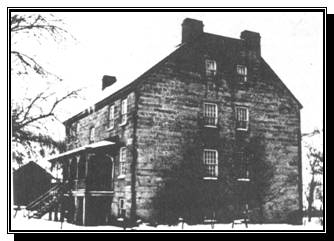A letter written by Robert Richardson to Mrs. Cleaver, dated 10 March 1997. Mr. Richardson gave Flora L. VerStraten a copy of this letter with permission to publish.
The Old Stone House - Bayless House
John Brown Bayless erected the remarkable dwelling in 1836 on the south side of Short Creek, behind and just east of the present Dairy Queen in the town of Rayland (as of Jan. 2008 Dairy Queen is still in that location). The details of its construction may be found in my book. Bayless, an abolitionist from Maryland, came to this area in 1829 with his wife, Elizabeth and several black servants who had refused to leave his household although he had granted them freedom. (pg. 224) The servants lived in a small house, which had been built by Bayless before the Old Stone House, which was close to the creek. Virginia Stringer Fleming, now living in Wheeling, (age 87) remembers her father telling of a tunnel that ran from the small house (now gone) to the river. The escaping slaves who were making their way to Mount Pleasant apparently used the tunnel. I have no written record of the Old Stone House as a station on the Underground Railroad. However, I do know that both Bayless and Stringer families were quite sympathetic to that movement. They, no doubt, would have been active in harboring or assisting any escaping slaves. (Read more from “Tilton Territory,” pages 224-25, 236-39, 247-49. Also “A Time and Place in Ohio” pages 35-41, 138, author, Robert Richardson)

(The Old Stone House built by John B. Bayless -1836)
(Photo courtesy of Robert Richardson)
The Stone house was about fifty-two feet in width and forty-two feet in depth. The hallway was enhanced by a typical colonial stairway with ornate wooden steps. An Italian artist was hired to paint the main hall. He painted a flowing waterfall from the peak of the stairs to the baseboard at the bottom. He combined silver and gold in penetrating detail and it was not uncommon for a visitor to shield himself from the splashing spray. On another great hall was enshrined a replica of William Penn’s treaty with the Indians with a charming English castle and grounds. And finally, a third panel depicting an early gristmill and the workmen associated with its operation, was created. The massive stone house was complete!